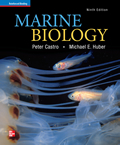1 A) Killer whale. B) Diatom. C) Copepod. D) Small fish. 2 A) 1 million calories B) 100 thousand calories C) 10 thousand calories D) 1 thousand calories 3 A) Sixth, second B) Second, sixth C) Sixth, first D) Third, second 4 A) Coral reefs. B) The Southern Ocean. C) Coastal upwelling areas. D) Central ocean gyres. 5 A) Trophic-level B) Food chain C) Food web D) Symbiotic relationship 6 A) Measuring the bioluminescence of zooplankton B) Comparing oxygen production by photosynthesis in a clear bottle vs the production of CO2 in a dark bottle due to respiration. C) Measuring nutrients in the water. D) Analyzing the content of biogenic sediments. 7 A) Greatly expanding due to more rapid evolution of species B) Remaining constant due to the vastness of the oceans and thus the stability of marine populations. C) Is declining mostly due to human impacts. D) The ecosystem is simply too large to measure accurately. 8 A) primary productivity B) the food chain C) the food web D) the carrying capacity 9 biodiversity is of importance to humans because ecosystem efficiency may decline as species are lost.A) True B) False 10 A) Conferences have not been held to discuss this issue. B) There is no evidence that diverse communities are more efficient at using resources than those that are less diverse. C) Scientists cannot actually measure how fast biodiversity is disappearing. D) Scientists have already identified most organisms and evaluated their use to humans. 11 A) Carrying capacity B) Primary production C) Exponential growth D) Expansion of trophic levels 12 A) Loss of biodiversity B) Logistic growth C) Exponential grown D) Species endangerment 13 resource partitioning are likely to be specialists rather than generalists.A) True B) False 14 A) Self-limiting. B) Exponential. C) Suffering from limited resources. D) Shown by a J-shaped curve. 15 A) A chiton grazing on algae. B) A tunicate sucking in plankton. C) A snail drilling a hole into a clam and then sucking out the flesh. D) A polychaete worm taking in bacteria-rich sediment. 16 A) Symbiosis. B) Coevolution. C) Commensalism. D) Mutualism. 17 A) Predation. B) An indirect interaction. C) A competitive interaction. D) Resource partitioning. 18 A) Mutualism. B) An inducible defense. C) A facultative symbiosis. D) Heterotrophy. 19 A) The specific abiotic habitat features to which it is adapted. B) The exact location where it lives. C) Its special role in a community and all of its ecological interactions. D) Its specific species behaviors. 20 A) True B) False 21 A) Its niche. B) A hiding place. C) A feeding area. D) A cleaning station. 22 A) Settling into deeper water B) Hatching where plankton is abundant C) Riding currents far out to sea D) Staying close to where their parents produced them 23 A) Primary production rate. B) Standing crop. C) Respiratory rate. D) Nutrient absorption rate. 24 A) Net primary productivity B) Essential biomass cycle C) Standing stock D) Trophic level reservoir 25 A) Primary productivity B) Preditor-prey relationship C) Decomposition by saprophytes D) Intraspecific competition 26 A) True B) False 27 A) True B) False 28 A) Denitrification by bacteria. B) Nitrous-oxides in acid rain. C) Weathering of rock. D) Nitrogen fixation from the atmosphere by cyanobacteria and archaea. 29 mesopelagic is the open-ocean zone that has enough sunlight for some use of vision by animals but not enough to support photosynthesis.A) True B) False 30 A) Littoral zone. B) Sublittoral zone. C) Epipelagic zone. D) Oceanic zone. 31 A) Tuna. B) Copepod. C) Squid. D) Diatom.





